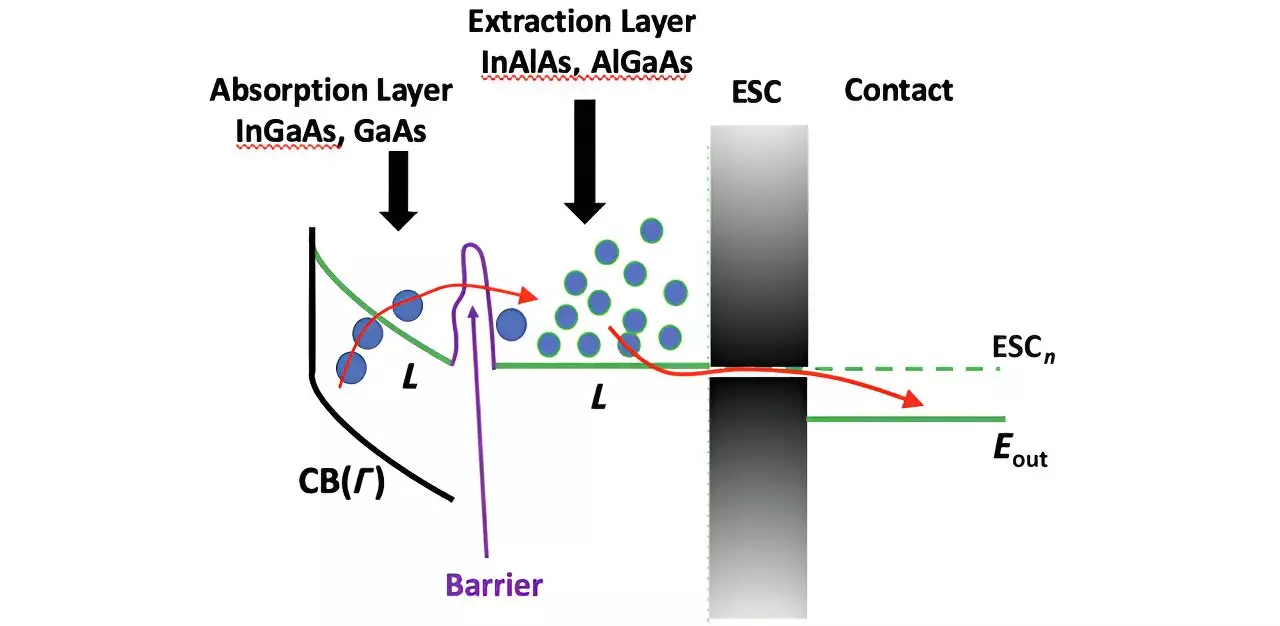In the landscape of renewable energy solutions, hot carrier solar cells have emerged as a compelling concept, piquing the interest of researchers and technologists alike. The potential of these cells to exceed the Shockley-Queisser limit—the theoretical peak efficiency for single-junction solar cells—offers a tantalizing glimpse into a future where solar technology might unlock vastly improved energy output. However, the road to practical implementation has been riddled with challenges, the most critical being the effective management of hot electrons, which are generated at elevated energy levels and must be rapidly extracted from the cell.
Current research efforts have concentrated on the concept of using satellite valleys, which are additional energy states in the conduction band, as temporary storage sites for these high-energy electrons prior to their extraction. This innovative approach requires a delicate balance in the configuration of the solar cell’s structure. Despite the promise shown by satellite valleys, various experimental results have indicated the presence of a significant parasitic barrier. This barrier manifests at the interface between the absorber and extraction layers, hindering the rapid transfer of hot electrons.
Understanding this barrier is essential since electron flow is influenced not merely by momentum but also by the real-space alignment of energy bands within the materials involved. Misalignment at the interfaces can lead to complications in electron movement and, subsequently, reduced efficiency of the solar cells under practical conditions.
A pioneering study published in the *Journal of Photonics for Energy* has recently illuminated the intricacies involved in the electron tunneling process between these carrier states. By employing an empirical pseudopotential method, the researchers were able to generate energy band structures that closely correlate with experimental observations at critical points. This analysis yielded substantial insights into how hot carriers interact with the heterostructure interfaces, which was previously poorly understood.
The study indicates a critical finding regarding the tunneling coefficient—a quantifying measure of how readily electrons can traverse the barriers at these interfaces. It was revealed that structures comprised of indium-aluminum-arsenide (InAlAs) and indium-gallium-arsenide (InGaAs) face significant challenges due to their energy band mismatch, leading to inefficient electron transfer. Disruptions as minor as atomic-scale roughness at the interface exacerbate this issue, supporting the trend of poor performance in experimental devices using these materials.
Interestingly, the research also highlights a more favorable outcome when evaluating the combination of aluminum gallium arsenide (AlGaAs) and gallium arsenide (GaAs). The specific aluminum composition utilized in this structural pairing promotes better alignment of the energy bands, reducing the parasitic barriers. Moreover, these materials can be engineered to an atomic precision, allowing for greater control over their characteristics.
Within this setup, the tunneling coefficient for electron transfer can achieve remarkably high values, reaching as much as 0.5 to 0.88, contingent upon the precise composition of AlGaAs selected. This evidently indicates a far more efficient electron transfer mechanism, which not only aids in the extraction of hot carriers but also enhances the possibility of employing valley photovoltaics—an innovative technique aiming to surpass the traditional limits imposed by single bandgap solar cells.
This newfound understanding of the tunneling dynamics between AlGaAs and GaAs constructs is pivotal. It indicates a promising avenue towards developing more efficient hot carrier solar cells, suggesting that optimal material selection and interface engineering could indeed lead to breakthroughs in solar energy efficiency. The ability to handle hot carriers effectively means that solar cells could become a more competitive source of clean energy, capable of generating higher outputs and contributing meaningfully to global energy needs.
As researchers continue to unravel the complexities associated with hot carrier solar cells, we may soon find ourselves on the cusp of a revolution in solar technology, one where the potential of these cells is fully realized, enhancing our transition to sustainable energy sources.


Leave a Reply